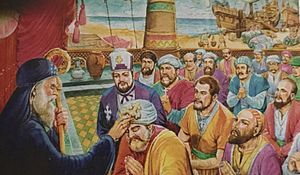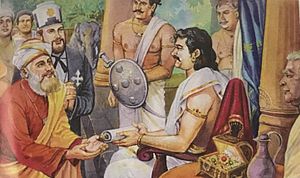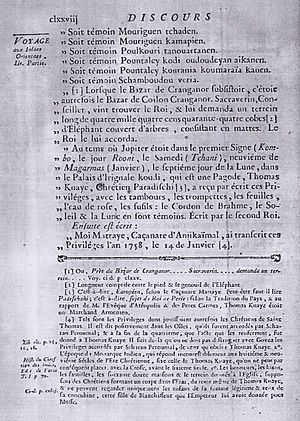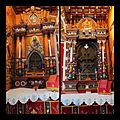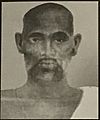Knanaya facts for kids
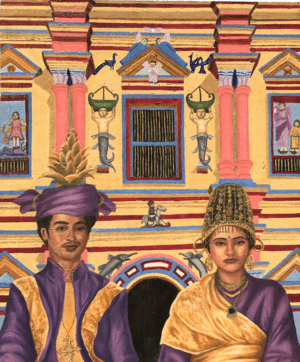
Knānāya Diaspora of Ancient Malabar
|
|
| Regions with significant populations | |
|---|---|
| c. 300,000 (Kerala, India; USA; elsewhere) | |
| Languages | |
| Malayalam; local languages
Liturgical: Syriac Written: Suriyani Malayalam |
|
| Religion | |
| Predominantly Syro-Malabar Catholic Church and Malankara Jacobite Syrian Orthodox Church | |
| Related ethnic groups | |
| Saint Thomas Christians, Malayalis, Cochin Jews |
The Knanaya are a special group of Saint Thomas Christians in Kerala, India. They are also called the Southists or Tekkumbhagar. This group is different because they usually marry only within their own community.
The Knanaya are different from another group called the Northists (Vaddakkumbhagar). There are about 300,000 Knanaya people living in India and other countries today.
The story of how the Saint Thomas Christians split into Northists and Southists goes back a long time. It began when a Syrian merchant named Thomas of Cana (Knāi Thoma) came to India. He led a group of Syriac Christians from Mesopotamia in the 4th or 8th century. The Knanaya believe they are descendants of Thomas of Cana and the people who came with him.
The arrival of this group was written down on special "Thomas of Cana copper plates." These plates were in Kerala until the 17th century. Then, they were taken to Portugal by a group called the Franciscan Order. People noticed the difference between the Knanaya and other Saint Thomas Christians during the time of Portuguese rule in the 16th century. This difference was seen throughout the time of European colonization.
Today, most Knanaya belong to two main churches. They are part of the Syro-Malabar Catholic Church (Kottayam Archeparchy) or the Jacobite Syrian Orthodox Church (Knanaya Archdiocese). They became more well-known in Kerala in the late 1800s. Many Knanaya moved away in the 1900s and 2000s, mostly to the west. They formed communities in places where Malayalam is not spoken. Large groups now live in Houston, Texas, and Chicago, Illinois, in the United States.
Contents
How the Knanaya Community Began
The first detailed writings about the split in India's Christian community are from the 16th century. The Saint Thomas Christian tradition says this split was about both location and family background. It says that the local Saint Thomas Christians first lived on the north side of Cranganore, the capital city of the Chera Empire.
Then, the Knanaya migrants from the Middle East arrived and settled on the south side. This is why they were called Northists and Southists. A famous Saint Thomas Christian scholar, Dr. Placid J. Podipara, wrote about this division. He said that the first Christians were joined by new local converts and by Christians who moved from other countries. He noted that the "Southists" came from the migration in the 4th century.
It was common in Kerala for communities to be divided by direction, even among Hindu groups. For example, the Nairs also had a north-south division. This might have been a custom that the Saint Thomas Christians learned from the Brahmins.
Thomas of Cana's Journey to India
The main reason for the split between the larger Saint Thomas Christian group and the smaller Knanaya group goes back to Thomas of Cana. He was a Syrian merchant. He led 72 Jewish-Christian families, a bishop named Uraha Mar Yausef, and other church leaders. They traveled from Mesopotamia to Cranganore, India. This happened in the 4th century, though some say it was as late as the 9th century.
This event likely shows a real migration of East Syrian Christians to India around that time. This migration started the connection between the region and the Church of the East. In the common stories, the Knanaya are the descendants of Thomas of Cana and his followers. The Northists, however, are believed to be descendants of the local Christians. These local Christians were converted by Thomas the Apostle centuries earlier.
The Oxford History of the Christian Church explains this division. It says that Jewish Christians who came with Knayil Thomma (Thomas of Cana) became known as 'Southists'. They saw themselves as different from the 'Northists'. The 'Northists' said they were direct descendants of the very first Christians in the country. They believed Apostle Thomas himself had converted their ancestors. They had lived in the northern parts of Kodungallur long before new groups arrived from Persia.
Parts of Thomas of Cana's arrival story are found in old songs. They are also mentioned in the Thomas of Cana copper plates. These plates were given to his followers by a local Hindu ruler. The plates gave Thomas's followers 72 social, economic, and religious rights. These rights came from Cheraman Perumal, the Chera king.
These plates were in Kerala when the Portuguese arrived in the early 1600s. But they were lost during Portuguese rule. Archbishop Francis Ros wrote in 1604 that the plates were taken to Portugal by the Franciscan Order. The Knanaya use these plates as proof that they are descendants of Thomas of Cana's group.
Translations of the Kollam Syrian Plates from the 9th century also mention Thomas of Cana. A Syrian Christian priest named Ittimani translated them in 1601. The French scholar Abraham Anquetil Duperron also translated them in 1758. Both translations noted that the fourth plate briefly mentioned Knai Thoma's arrival. People believe this was a note about the rights given to Christians earlier by Cheraman Perumal. However, the current fourth plate does not have this paragraph. It is thought to be a later copy. Historian Istavan Percvel thinks that the Kollam Syrian plates and the Thomas of Cana plates were once kept together.
Jewish-Christian Roots
The Knanaya tradition says that the Syriac Christian migrants who came with Thomas of Cana were Jewish-Christians. Scholars from the community say this is true. They note that Jewish-Christian groups in Mesopotamia were a big part of the early Church of the East. Also, Jewish and Christian merchants from that area traded with Kerala across the Arabian Sea.
The community also points to their culture as proof of their Jewish-Christian background. This is especially true for their folk songs. These songs were first written on palm leaves in the 17th century. Many old songs suggest the migrants were of Jewish descent. For example, the song Nallor Orosilam (The Good Jerusalem) says the migrants prayed at the tomb of the Jewish Prophet Ezra before leaving for India.
Several Jewish scholars have noticed that the Knanaya share cultural similarities with the Cochin Jews of India. This suggests a historical connection between the two groups.
In 1939, Knanaya politician and author Joseph Chazhikaden wrote a book about his community. In it, he included some ideas about their Jewish claim. Chazhikaden built on the Thomas of Cana story. He said that Thomas's followers came from Judea. According to Chazhikaden, this group became Christians but kept their unique culture. They were eventually forced to leave their homeland and moved to Cranganore. There, they were welcomed by the ruler Cheraman Perumal. They lived near the local "Northist" Saint Thomas Christians but stayed separate from them. Many Knanaya today accept this story as fact, while others do not. Some Northists disagree with and criticize these Knanaya origin stories.
Old Stories of Rivalry
In some old stories from the colonial era, Thomas of Cana was said to have had two wives or partners. One was the ancestor of the Southists, and the other was the ancestor of the Northists. Many stories tried to explain the status of each wife. Both Southists and Northists used these stories to claim their group was better.
Today, scholars from both groups do not believe these stories are true. They think these tales came from rivalry between the Saint Thomas Christians and the Knanaya. In most of these stories, the Southists' ancestor was Thomas's Syrian wife. The Northists' ancestor was a local Saint Thomas Christian or Nair woman. This implied that the Southists were Thomas's true heirs. In other versions, both wives were from Kerala, but the Southists' ancestor was from a higher social group.
Some Northists had their own versions of these stories. They claimed the Knanaya came from a dobi (washerwoman). In some tales, she became Thomas's partner. In others, she married a lower-caste boy. This idea comes from a Portuguese document from 1676. It is likely a fake document made by a Carmelite priest.
Pius Malekandathil, a historian and Northist priest, believes the "two wives" story was simply made up because of rivalry. He thinks it started in the medieval period. This was when the two Christian groups were trying to gain more power and wealth. Malekandathil also says that the "two wives" story is not the accepted tradition in Kerala. Instead, the local Saint Thomas Christians were called "Northists" because they lived in the northern part of Cranganore. The Knanaya migrants, led by Thomas of Cana, were given the southern side of the city. This led to them being called "Southists."
Images for kids
See also
 In Spanish: Knanayas para niños
In Spanish: Knanayas para niños


